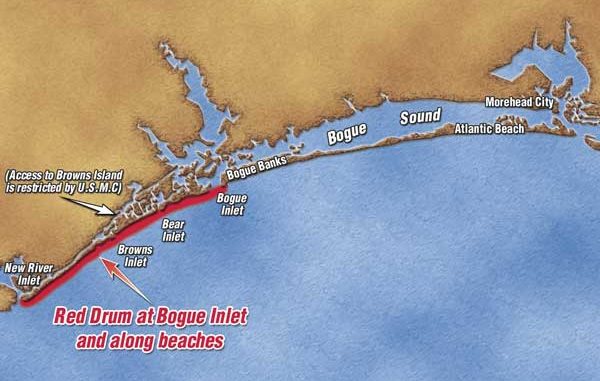
During February, nearshore waters at Swansboro become gin clear, and sight-casting to red drum draws crowds.
There was a raw-edged chill in the air, cutting to the cheekbones as Capt. Jeff Cronk steered his 21-foot Triton center-console out boat to sea through Bogue Inlet.
For a couple of reasons Cronk had left Dudley’s Marina dock well after the sun was above the Atlantic Ocean. First, while many of his summer trips begin early because that’s when it’s cool, colder temperature were the last thing he wanted to feel this winter’s day. The second reason was the sun’s distance above the eastern horizon.
“The water is so clear this time of year it’s easy to see redfish,” Cronk said. “But the sun’s not in the right position to spot them in the surf until 9 o’clock in the morning. It stays right until about 2 p.m. After that time, the sun is coming out of the west, behind the fish, so you can’t see them as well.”
Cronk might have been speaking about sight fishing for red drum in the marshes of his summer haunts near Swansboro. But instead he was talking about winter sight fishing for surf reds.
While anglers may read about or even experience poling wading or easing through salt marshes in a small boat to get within range for a single cast at one redfish during summer, Cronk and his angling partner, Capt. Mike Taylor, fish for schools of hundreds, sometimes thousands, of redfish in the surf zone during winter.
Cronk navigated his boat out to the shoals on the ocean side of Bogue Inlet and kept the the craft on plane to prevent grounding the motor’s skeg and propeller on the sandy bottom.
“There’s a school over there,” Taylor said with a shout and pointed. “Look, the water’s all purple.”
Cronk slowed the boat to idle speed once he found a channel. He let us drift a moment on the falling tide to gauge the comparative pushes and pulls of wind and tide. Then he idled the engine a bit more to move the boat in a position so it would drift at an angle toward the fish. If the anglers didn’t hook a fish from the school, the boat would drift past as it moved out of casting range.
These two expert anglers cast several times. A couple of nearby boats had found schools of redfish as well. The duo watched other anglers as they teased the redfish in their schools. There were a few followers, but very few takers.
“These schools in the inlet have been beaten to death,” Taylor said. “We’ll probably have to move on out to the beaches to get better action.”
The red drum were tantalizingly close. Some followed the soft lures Cronk and Taylor cast, and one pair of redfish resulted in a double hookup. But seeing a school of 200 redfish, casting to them and getting a hookup every several dozen casts was like pulling the handle of a Vegas slot machine. Other anglers may gamble away their fishing time, sticking with their first visible school of the day. But Cronk agreed with Taylor, and they sped away across the inlet bars to the south, seeking hotter action.
“The beaches to the north, such as Emerald Isle, don’t hold redfish,” Cronk said. “I don’t know if beach nourishment has anything to do with it. But the sand they pump onto the beaches may not have the conditions for sea life necessary to hold red drum. It may bury sand fleas and other things redfish eat. But whatever the reason, we find more red drum off the beaches at Bear and Browns islands.”
Browns Island is under the jurisdiction of the U.S. Marine Corps. Putting one’s feet on land there or landing a boat is a serious violation of security and can result in arrest and a fine if convicted. But nothing prevents boat anglers from fishing public waters at the island’s ocean-side beach.
The anglers moved slowly, watching the surf for signs of magenta-tinted water. The wind was light and from the west, a direction that knocks down waves to create a glassy smooth surface, perfect for spotting red drum schools in the crystal-clear water.
Cronk said as long as the wind came from the north around to west or is otherwise light, it’s a good day for sight fishing. Prime months for sight fishing are October through March. But the surf is calmest and clearest when it’s coldest (usually February) and also full of fish that have been driven from the inland marshes by cold temperatures.
Juvenile red drum remain in the marshes for the most part until they reach maturity at age 4 and a length of 27 inches or longer. Then these adult fish head to the ocean.
But when it’s cold, the juvenile fish either form large schools that hover dormant in the marshes or head to the slightly warmer water along the shorelines at the ocean. The ideal water temperature for surf boating for redfish is between 42 and 48 degrees.
The anglers watched for birds diving on baitfish, porpoises spouting and for any disruption or discoloration that indicated a school of red drum was balled up in the surf.
“The water is clear all year long off of Bear and Browns Islands,” Cronk said. “But in winter, there’s no swell, so you can catch it on a calm day and easily find the fish. Sometimes someone else shows you where the fish are, like that boat over there.”
Cronk moved within earshot and hailed the anglers in the other boat. The boat was drifting along with the motor idling. One angler cast from the bow, while the other operated the boat with one hand at the wheel and the other holding a spinning rod. Both cast into water tinged purple and were rewarded with hookups.
After a brief “what-are-they -biting?” question, Cronk moved farther south. At a projection from the beach front, with a shelly bottom that seemed to jut a few inches higher than the surrounding bottom, he spotted some porpoises.
“Porpoises feed on redfish,” Cronk said. “We catch them sometimes with teeth marks on them where they got away. A porpoise catches a red drum and shakes it to tear it apart. Sometimes the birds start diving into the red drum school at the same time, and it’s quite a sight.”
In winter, red drum feed on small minnows, squid and sand fleas (mole crabs). The fish are slower moving and a bit lazier, much less prone to being shy of a boat moving near them. Nevertheless, the anglers kept the boat idling as they made casts to take the temperature of the school in front of them.
“If the boat is running, you need to leave it running,” Cronk said. “It’s the suddenness of turning off the motor, turning it on, throttling it up or down that alarms the school. You also don’t want to drop something hard in the bottom of the boat or bang an anchor against the deck. If you spook the fish, they might move or get a case of lockjaw.”
“But they’re still a lot less spooky than when the water is warm in spring, summer and fall,” Taylor said. “You might not be able to get within casting range running the motor at all in the summer. But in winter, sometimes it seems like you’re feeding goldfish in a backyard pond. The fish can move right beneath the boat.”
Thanks to polarized sunglasses and the sun at their backs, the professional anglers could spot schools as well as renegade fish that had broken away from the pack. The schools ebbed and flowed with the rise and fall of the waves as the anglers followed. Sometimes the redfish washed up onto the beach, then were swept back to sea as the waves receded.
The anglers were casting Berkley Gulp soft-plastic lures rigged on 1/16- to ¼-ounce jig heads. They used Fenwick 7-foot medium-action spinning rods paired with Abu Garcia Cardinal 804 reels spooled with 10-pound-test crystal color Berkley Fireline superbraid line. An 18-inch leader of 25-pound fluorocarbon leader was tied to the line.
“The clear leader increases strikes in the clear water because the fish can’t see it,” Taylor said. “It also gives you something to grab onto when unhooking and releasing the fish. If you’re hands are wet the small diameter and abrasiveness of the Fireline can cut your hand when you’re lifting a big fish.”
For juvenile fish, the reds they began catching were indeed big fish. The schools were of mixed sizes of fish ranging from 18 to 28 inches long, or a weight of 3 to 10 pounds. Average length was about 24 inches with a weight of 6 pounds or so, which was plenty of redfish to put a strain on light spinning tackle.
Although neither of the anglers tried catching reds with a fly, I had to give it a try. The two guides were catching a fish every cast. Some of the fish were reached with long casts and some appeared 5 feet off the transom. They played the fish using tight drags and eventually other boats spotted the action and joined to fish the same schools. When the other boats entered the picture, Taylor eased an anchor over the side.
“If everyone starts chasing them, the fish will scatter or move offshore,” Taylor said. “But if everyone stays calm and casts to the fish from anchor, they might stick around all day.”
After catching dozens of reds with spinning gear, I tried a 9-weight fly rod with an intermediate sink-tip line, extruded tapered leader and a 12-pound test fluorocarbon tippet. The combination allowed long casts, all the way to the breakers from the anchored boat. Several patterns resulted in one or two fish following the fly until Taylor reminded me a rattle shrimp pattern had been followed by a couple of fish I tried to interest at Bogue Inlet. After an hour’s fishing, I landed four redfish with fly tackle, while Cronk and Taylor continued landing a redfish with every cast.
“The trick to catching redfish this time of year is to give them something with some scent to it as extra enticement,” Taylor said. “You can touch up a lure with a paste-type scent that stays on well in the surf and against being dragged through the sand, or you can fish a scent-impregnated bait such as the Gulp and not have to worry about a Spanish mackerel or bluefish cutting it off like you do when the water is warmer. The scent-impregnated lures are expensive, so you don’t want to lose too many of them. We like the 4-inch Berkley Gulp Shrimp in pearl-white or blue colors or the 4-inch Gulp Pogy in the pearl-white or smelt-white patterns.”
“Varying the speed of the descent by switching jig head sizes is a good tactic if they aren’t biting,” Cronk said. “You don’t want the lure to sink too fast. If they aren’t biting, try switching to a lighter jig head. You want the lure to sink slowly, fluttering in front of the fish’s face and giving him a good sniff.
“If you don’t get a strike on the initial fall, hop it up and let it flutter back down again. Sometimes all you have to do is cast and retrieve slowly and the wave action against the lure and the line will move the lure up and down enough to draw strikes. Most of the time the strike comes as it hits the bottom.”
Another tactic the two pros used was fishing with a tight drag. The drag setting was well over half the weight of the line, so they could land fish quickly, unhook and release them, then make another cast. Such action can be tiring to anyone not used to it, as well as the constant seesawing of a boat anchored in the breakers.
“Keep your knees bent and be sure there’s something nearby to grab onto if you lose your balance.” Cronk said. “Keep one eye on the waves and the other one on the fish, then all you have to do is hit the water with a jig.”


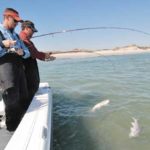
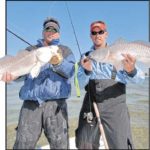
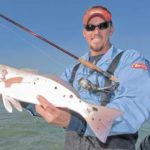
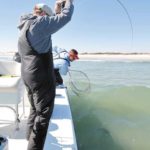

Be the first to comment